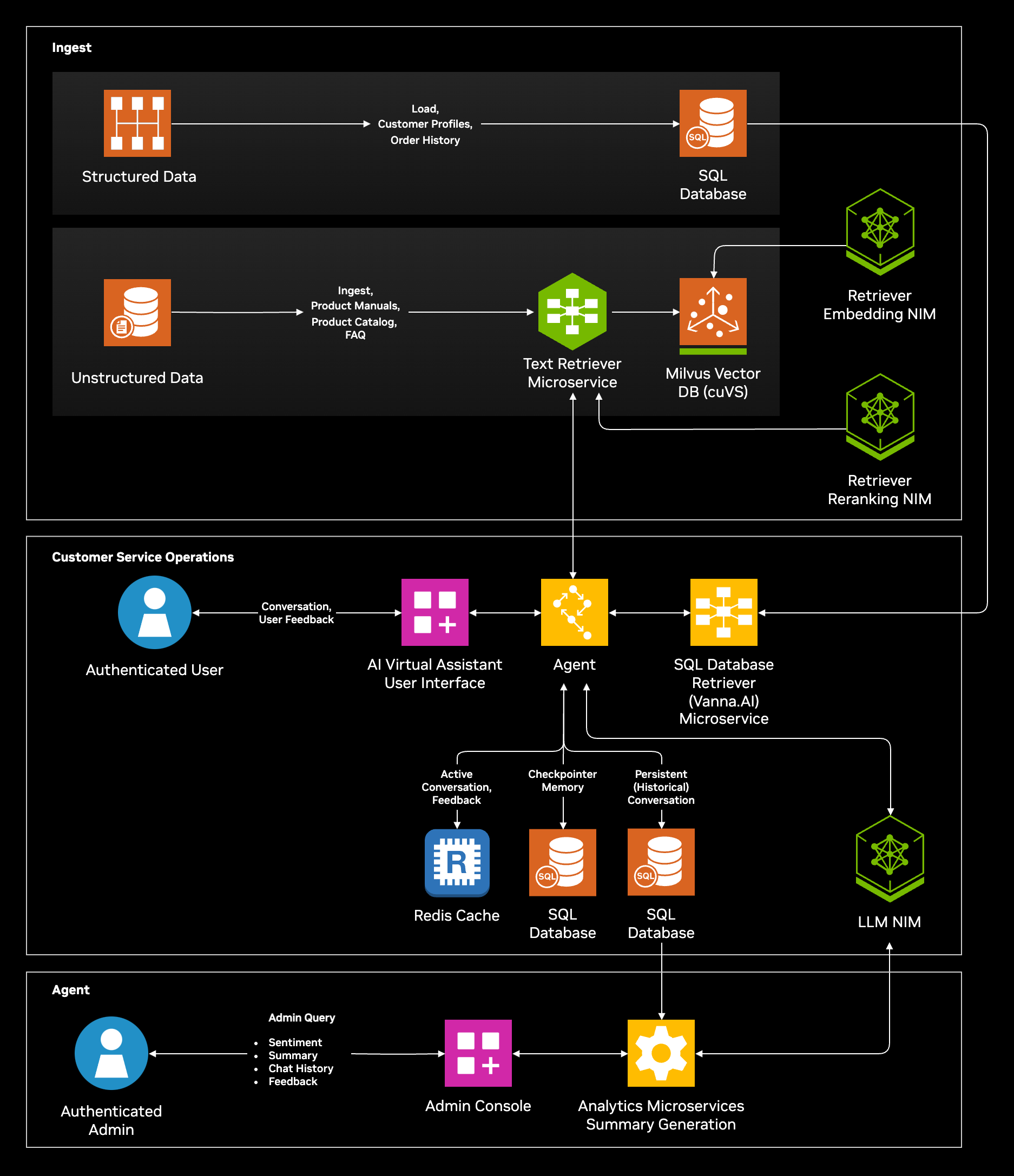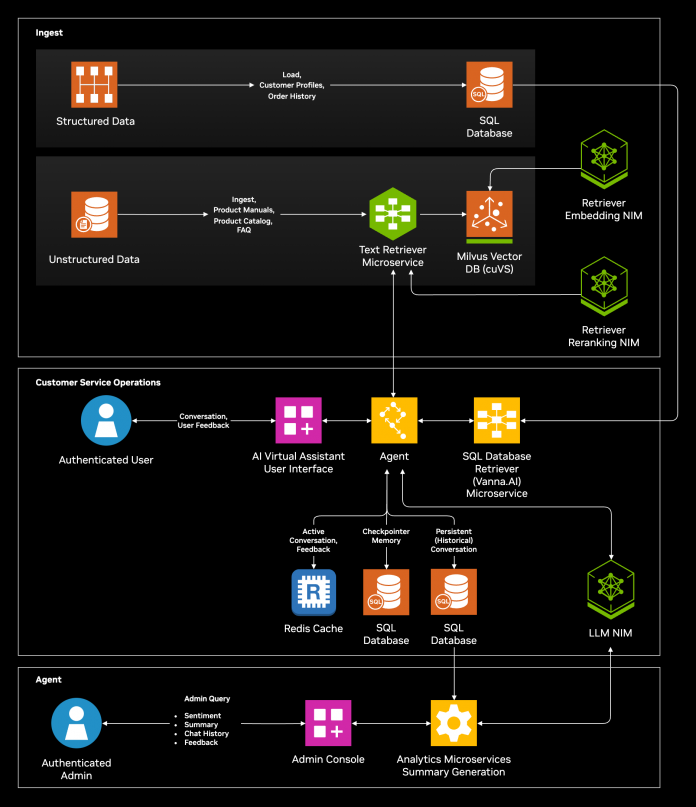In today’s fast-paced business environment, providing exceptional customer service is no longer just a nice-to-have—it’s a necessity. Whether addressing technical issues, resolving billing questions, or providing service updates, customers expect quick, accurate, and personalized responses at their convenience. However, achieving this level of service comes with significant challenges.
Legacy approaches, such as static scripts or manual processes, often fall short when it comes to delivering personalized and real-time support. Additionally, many customer service operations rely on sensitive and fragmented data, which is subject to strict data governance and privacy regulations. With the rise of generative AI, companies aim to revolutionize customer service by enhancing operational efficiency, cutting costs, and maximizing ROI.
Integrating AI into existing systems presents challenges related to transparency, accuracy, and security, which can impede adoption and disrupt workflows. To overcome these hurdles, companies are leveraging generative AI-powered virtual assistants to manage a wide range of tasks, ultimately improving response times and freeing up resources.
This post outlines how developers can use the NVIDIA AI Blueprint for AI virtual assistants to scale operations with generative AI. By leveraging this information, including sample code, businesses can meet the growing demands for exceptional customer service while ensuring data integrity and governance. Whether improving existing systems or creating new ones, this blueprint empowers teams to meet customer needs with efficient and meaningful interactions.
Smarter AI virtual assistants with an AI query engine using retrieval-augmented generation
When building an AI virtual assistant, it’s important to align with the unique use case requirements, institutional knowledge, and needs of the organization. Traditional bots, however, often rely on rigid frameworks and outdated methods that struggle to meet the evolving demands of today’s customer service landscape.
Across every industry, AI-based assistants can be transformational. For example, telecommunications companies, and the majority of retail and service providers, can use AI virtual assistants to enhance customer experience by offering support 24 hours a day, 7 days a week while handling a wide range of customer queries in multiple languages and providing dynamic, personalized interactions that streamline troubleshooting and account management. This helps reduce wait times and ensures consistent service across diverse customer needs.
Another example is within the healthcare insurance payor industry, where ensuring a positive member experience is critical. Virtual assistants enhance this experience by providing personalized support to members, addressing their claims, coverage inquiries, benefits, and payment issues, all while ensuring compliance with healthcare regulations. This also helps reduce the administrative burden on healthcare workers.
With the NVIDIA AI platform, organizations can create an AI query engine that uses retrieval-augmented generation (RAG) to connect AI applications to enterprise data. The AI virtual assistant blueprint enables developers to quickly get started building solutions that provide enhanced customer experiences. It is built using the following NVIDIA NIM microservices:
- NVIDIA NIM for LLM: Brings the power of state-of-the-art large language models (LLMs) to applications, providing unmatched natural language processing with remarkable efficiency.
- NVIDIA NeMo Retriever NIM: This collection provides easy access to state-of-the-art models that serve as foundational building blocks for RAG pipelines. These pipelines, when integrated into virtual assistant solutions, enable seamless access to enterprise data, unlocking institutional knowledge via fast, accurate, and scalable answers.
- NeMo Retriever Embedding NIM: Boosts text question-answering retrieval performance, providing high-quality embeddings for the downstream virtual assistant.
- NeMo Retriever Reranking NIM: Enhances the retrieval performance further with a fine-tuned reranker, finding the most relevant passages to provide as context when querying an LLM.
The blueprint is designed to integrate seamlessly with existing customer service applications without breaking information security mandates. Thanks to the portability of NVIDIA NIM, organizations can integrate data wherever it resides. By bringing generative AI to the data, this architecture enables AI virtual assistants to provide more personalized experiences tailored to each customer by leveraging their unique profiles, user interaction histories, and other relevant data.
A blueprint is a starting point that can be customized for an enterprise’s unique use case. For example, integrate other NIM microservices, such as the Nemotron 4 Hindi 4B Instruct, to enable an AI virtual assistant to communicate in the local language. Other microservices can enable additional capabilities such as synthetic data generation and model fine-tuning to better align with your specific use case requirements. Give the AI virtual assistant a humanlike interface when connected to the digital human AI Blueprint.
With the implementation of a RAG backend with proprietary data (both company and user profile and their specific data), the AI virtual assistant can engage in highly contextual conversations, addressing the specifics of each customer’s needs in real-time. Additionally, the solution operates securely within your existing governance frameworks, ensuring compliance with privacy and security protocols especially when working with sensitive data.
Three building blocks for creating your own AI virtual assistant
As a developer, you can build your own AI virtual assistant that retrieves the most relevant and up-to-date information, in real time, with ever-improving humanlike responses. Figure 1 shows the AI virtual assistant architecture diagram which includes three functional components.

1. Data ingestion and retrieval pipeline
Pipeline administrators use the ingestion pipeline to load structured and unstructured data into the databases. Examples of structured data include customer profiles, order history, and order status. Unstructured data includes product manuals, the product catalog, and supporting material such as FAQ documents.
2. AI agent
The AI virtual assistant is the second functional component. Users interact with the virtual assistant through a user interface. An AI agent, implemented in the LangGraph agentic LLM programming framework, plans how to handle complex customer queries and solves recursively. The LangGraph agent uses the tool calling feature of the Llama 3.1 70B Instruct NIM to retrieve information from both the unstructured and structured data sources, then generates an accurate response.
The AI agent also uses short-term and long-term memory functions to enable multi-turn conversation history. The active conversation queries and responses are embedded so they can be retrieved later in the conversation as additional context. This allows more human-like interactions and eliminates the need for customers to repeat information they’ve already shared with the agent.
Finally, at the end of the conversation, the AI agent summarizes the discussion along with a sentiment determination and stores the conversation history in the structured database. Subsequent interactions from the same user can be retrieved as additional context in future conversations. Call summarization and conversation history retrieval can reduce call time and improve customer experience. Sentiment determination can provide valuable insights to the customer service administrator regarding the agent’s effectiveness.
3. Operations pipeline
The customer operations pipeline is the third functional component of the overall solution. This pipeline provides important information and insight to the customer service operators. Administrators can use the operations pipeline to review chat history, user feedback, sentiment analysis data, and call summaries. The analytics microservice, which leverages the Llama 3.1 70B Instruct NIM, can be used to generate analytics such as average call time, time to resolution, and customer satisfaction. The analytics are also leveraged as user feedback to retrain the LLM models to improve accuracy.
You can find the complete example of how to get started with this Blueprint on the NVIDIA AI Blueprint GitHub repository.
Get to production with NVIDIA partners
NVIDIA consulting partners are helping enterprises adopt world-class AI virtual assistants built using NVIDIA accelerated computing and NVIDIA AI Enterprise software, which includes NeMo, NIM microservices, and AI Blueprints.
Accenture
The Accenture AI Refinery built on NVIDIA AI Foundry helps design autonomous, intent-driven customer interactions, enabling businesses to tailor the journey to the individual through innovative channels such as digital humans or interaction agents. Specific use cases can be tailored to meet the needs of each industry, for example, telco call centers, insurance policy advisors, pharmaceutical interactive agents or automotive dealer network agents.
Deloitte
Deloitte Frontline AI enhances the customer service experience with digital avatars and LLM agents built with NVIDIA AI Blueprints that are accelerated by NVIDIA technologies such as NVIDIA ACE, NVIDIA Omniverse, NVIDIA Riva, and NIM.
Wipro
Wipro Enterprise Generative AI (WeGA) Studio accelerates industry-specific use cases including contact center agents across healthcare, financial services, retail, and more.
Tech Mahindra
Tech Mahindra is leveraging the NVIDIA AI Blueprint for digital humans to build solutions for customer service. Using RAG and NVIDIA NeMo, the solution provides the ability for a trainee to stop an agent during a conversation by raising a hand to ask clarifying questions. The system is designed to connect with microservices on the backend with a refined learning management system) which can be deployed across many industry use cases.
Infosys
Infosys Cortex, part of Infosys Topaz, is an AI-driven customer engagement platform that integrates NVIDIA AI Blueprints and the NVIDIA NeMo, Riva, and ACE technologies for generative AI, speech AI, and digital human capabilities to deliver specialized and individualized, proactive, and on-demand assistance to every member of a customer service organization, consequently playing a pivotal role in enhancing customer experience, improving operational efficiency, and reducing costs.
Tata Consultancy Services
The Tata Consultancy Services (TCS) virtual agent, powered by NVIDIA NIM, and integrated with ServiceNow’s IT Virtual Agent is designed to optimize IT and HR support. This solution uses prompt-tuning and RAG to improve response times, accuracy, and provide multi-turn conversational capabilities. Benefits include reduced service desk costs, fewer support tickets, enhanced knowledge utilization, faster deployment, and a better overall employee and customer experience.
Quantiphi
Quantiphi is integrating NVIDIA AI Blueprints into its conversational AI solutions to enhance customer service with lifelike digital avatars. These state-of-the-art avatars, powered by NVIDIA Tokkio and ACE technologies, NVIDIA NIM microservices and NVIDIA NeMo, seamlessly integrate with existing enterprise applications, enhancing operations and customer experiences with increased realism. Fine-tuned NIM deployments for digital avatar workflows have proven to be highly cost-effective, reducing enterprise spending on tokens.
SoftServe
SoftServe Digital Concierge, accelerated by NVIDIA AI Blueprints and NVIDIA NIM microservices, uses NVIDIA ACE, NVIDIA Riva, and the NVIDIA Audio2Face NIM microservice to deliver a highly realistic virtual assistant. Thanks to the Character Creator tool, it delivers speech and facial expressions with remarkable accuracy and lifelike detail.
With RAG capabilities from NVIDIA NeMo Retriever, SoftServe Digital Concierge can intelligently respond to customer queries by referencing context and delivering specific, up-to-date information. It simplifies complex queries into clear, concise answers and can also provide detailed explanations when needed.
EXL
EXL’s Smart Agent Assist offering is a contact center AI solution leveraging NVIDIA Riva, NVIDIA NeMo, and NVIDIA NIM microservices. EXL plans to augment their solution using the NVIDIA AI Blueprint for AI virtual agents.
This week at NVIDIA AI Summit India, NVIDIA consulting partners announced a collaboration with NVIDIA to transform India into a Front Office for AI. Using NVIDIA technologies, these consulting giants can help customers tailor the customer service agent blueprint to build unique virtual assistants using their preferred AI model—including sovereign LLMs from India-based model makers—and run it in production efficiently on the infrastructure of their choice.
Get started
To try the blueprint for free, and to see system requirements, navigate to the Blueprint Card.
To start building applications using those microservices, visit the NVIDIA API catalog. To sign in, you’ll be prompted to enter a personal or business email address to access different options for building with NIM. For more information, see the NVIDIA NIM FAQ.
This post was originally published on 10/23/2024.

